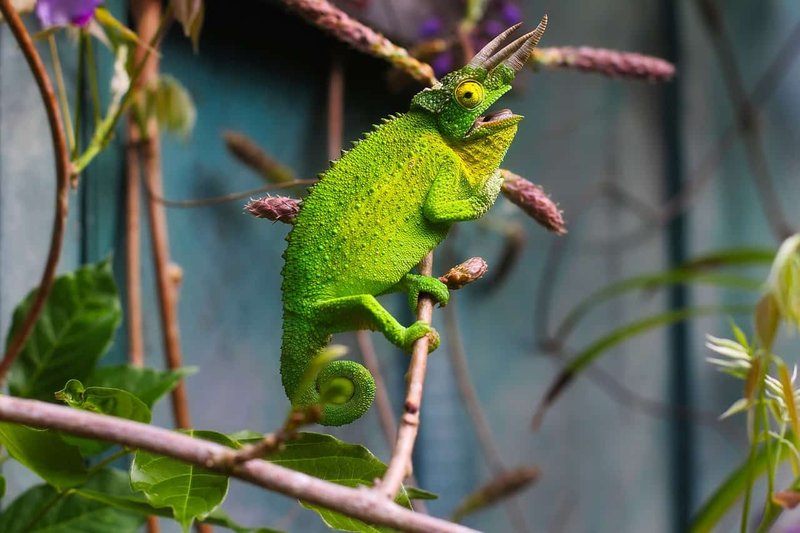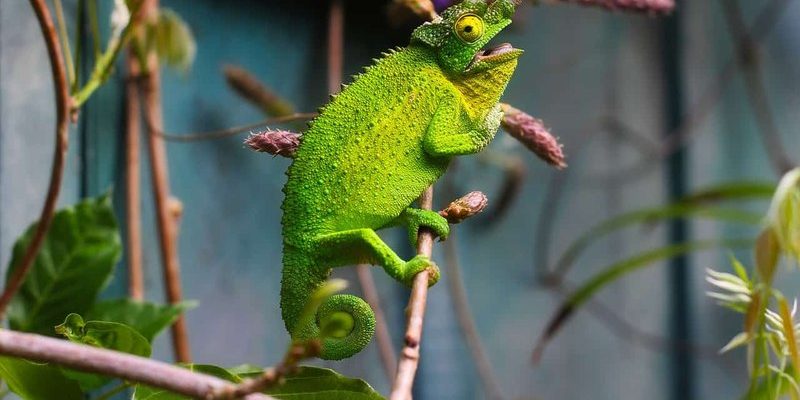
These lizards, primarily found in Madagascar and Africa, are not just about flashy appearances. They have unique features and behaviors that set them apart from other reptiles. If you’re curious about what makes chameleons so special, let’s dive into some of the most fascinating facts about them. You might be surprised by what you learn!
1. Color Change: More Than Just Camouflage
You might think that chameleons change color simply to blend in with their surroundings, but it’s actually more complex. They change color for various reasons, including communication and temperature regulation. When a chameleon feels threatened, it might darken its colors to appear more intimidating.
Moreover, during courtship, males often display bright hues to attract females. It’s kind of like a flashy fashion show, where the brightest and boldest colors win the day! So, while blending into the background is a part of their color-changing ability, it’s also a vital tool for social interactions.
How Color Change Works
The magic behind chameleons’ color changes lies in special pigment cells called chromatophores. These cells contain different pigments, and by expanding or contracting these cells, chameleons can alter their skin color almost instantly. It’s like having a color palette literally at their fingertips!
In addition, they also have layers of other cells like iridophores and melanophores that help enhance color or create patterns. So, when you see a chameleon flaunting its dazzling colors, you’re witnessing a remarkable display of nature’s artistry!
2. A Unique Tongue for Catching Prey
Chameleons have one of the most incredible tongues in the animal world. Their tongues can be up to twice the length of their bodies! Think about that for a second—a creature can extend its tongue to snag insects from a distance without moving its body.
This amazing tongue is not just long; it’s also highly specialized. It’s covered in a sticky substance that allows chameleons to catch their prey with great precision. When they spot an insect, they can launch this tongue at lightning speed—sometimes in just a fraction of a second.
The Science Behind the Speed
The rapid extension of their tongues is made possible by a unique muscle mechanism. This allows the tongue to launch off like a slingshot. When it strikes the prey, the sticky tip ensures that the bug doesn’t escape. In a way, it’s like having a built-in fishing rod that catches dinner on the go!
3. Their Eyes Can Move Independently
One of the most distinctive features of chameleons is their remarkable vision. Their eyes can move independently of each other, providing them with a nearly 360-degree view of their surroundings. Imagine being able to look at two different things at once without turning your head!
This unique trait is particularly useful when spotting potential threats or prey. A chameleon can keep watch for predators while simultaneously scanning for dinner. It’s like having a superpower for survival!
How Their Eyes Work
Chameleons have a specialized structure in their eyes called the fovea that allows them to see depth and judge distances accurately. This is especially important for their hunting strategy, as they need to accurately gauge how far away their target is before launching their tongue.
4. Chameleons Don’t Just Blend In
While chameleons are famous for being masters of disguise, they actually stand out in their own ways. Many species boast vibrant colors and intricate patterns that serve as warning signals to potential predators. For instance, a brightly colored chameleon could indicate that it’s toxic or unpalatable.
This means that, rather than just hiding, they can also flaunt their colors to send messages to other animals. It’s like wearing a neon sign that says “Stay away!”
Color Variations Across Species
Different chameleon species have unique coloration that reflects their environment and behaviors. For instance, the Panther Chameleon showcases a stunning mix of blues, reds, and greens, while the Jackson’s Chameleon is known for its horns and vibrant greens. Each pattern serves its purpose, whether it be mating, warning, or camouflage.
5. Chameleons Have a Slow Metabolism
Unlike many reptiles, chameleons have a slow metabolism, which is a major reason why they don’t actively hunt all the time. This slower pace means they don’t need to eat as frequently. They can go days without food, surviving on the energy they’ve stored up.
Although this can be an advantage in their natural habitat, it also means that they need to be strategic about when and how they hunt. Their slow lifestyle allows them to conserve energy, making the most out of each opportunity when they spot a meal.
Impact on Their Lifestyle
This slow metabolism also means that chameleons can be quite picky eaters. They usually prefer live insects, like crickets and grasshoppers, but they often wait patiently for the right moment to strike, rather than chasing down their food like other predators.
6. They Come in Different Sizes
While many people picture chameleons as small lizards, they actually come in a variety of sizes. The smallest chameleon, the Pygmy Chameleon, is about the size of a pea, while the largest, the Parson’s Chameleon, can grow over two feet long!
This size variation often reflects their habitat. Smaller chameleons tend to inhabit dense forests where they can blend in with tiny branches and leaves, while larger ones may be found in more open areas where their size allows them to dominate.
Size and Adaptation
Different sizes also come with different adaptations. Larger chameleons often have more vibrant colors and intricate patterns as a means of communication, while smaller ones might use stealth to avoid predators. Size is just one more factor that contributes to the incredible diversity of these creatures.
7. Chameleons Are Territorial Creatures
Many chameleon species are quite territorial. Males often engage in displays of dominance, showing off their colors to warn other males to steer clear of their turf. Think of it like a game of poker, where each player tries to read the other’s moves and signals.
When two males cross paths, they may perform elaborate displays, puffing up their bodies and changing colors to assert dominance. If that doesn’t work, things might escalate to physical confrontations. This behavioral dance is not just about space; it’s also about attracting mates.
The Role of Territory in Mating
Being territorial means that a male with a prime spot may have better access to females looking for mates. Thus, having a good territory can significantly impact their reproductive success.
8. They Can Live a Long Time
Chameleons have surprisingly long lifespans for reptiles, with some species living up to 10 years or more in captivity. In the wild, they may face more challenges, but those that survive can enjoy a lengthy life.
This longevity is partly due to their slow metabolism, which slows down the aging process. In captivity, with proper care, they can thrive, making them popular pets for reptile enthusiasts.
Care Considerations for Pet Chameleons
If you’re thinking about getting a chameleon as a pet, it’s essential to provide the right environment, including the right temperature, humidity, and diet. Proper care can help extend their lifespan and ensure they live a healthy, happy life.
9. Chameleons Have Unique Feet
Chameleons have specialized feet that help them climb and grip branches easily. Their toes are fused into two separate clumps, kind of like a pair of tongs, allowing them to grasp onto branches effectively.
This unique foot structure makes them exceptional climbers, perfect for navigating their arboreal habitats in search of food and mates. It’s like having built-in climbing gear!
The Importance of Their Feet
This adaptation is crucial for survival. In their natural habitat, they often need to navigate through treetops to avoid predators. So, these unique feet are not just cool-looking; they play a vital role in their daily lives.
10. A Variety of Species with Unique Traits
Chameleons are not a single species but a diverse group with around 200 recognized species. Each species has its quirks and adaptations suited to its environment. For instance, some may have specific colors or patterns that help them survive in particular habitats.
This diversity makes chameleons one of the most interesting groups of reptiles to study. Each species has unique adaptations, whether it’s for climate, habitat, or interaction with other creatures.
Celebrating Chameleon Diversity
From the tiny Pygmy Chameleon to the grand Parson’s Chameleon, there’s an entire world of fascinating traits and behaviors to explore. Each species tells a story of survival and adaptation, making the study of these creatures endlessly intriguing.
In conclusion, chameleons are more than just their color-changing abilities. They’re fascinating creatures with unique traits that have evolved over millions of years. Whether you admire their vibrant colors, incredible eyesight, or their amazing tongues, there’s no denying that chameleons deserve a spot on the list of nature’s most remarkable beings. So, the next time you see one, remember there’s a whole world of wonders behind those shifting scales!

